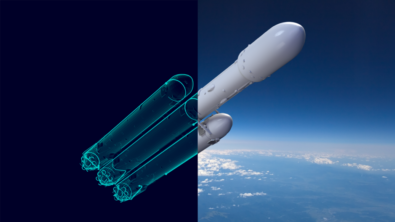Structural importance in MBSE for aerospace

Modern aircraft are increasingly interconnected networks of electrical control systems, navigation systems and even entertainment platforms for passengers. But under all of the complexity of the electric, electronic and software systems of these craft are the mechanical structures aerospace engineers have been optimizing for decades. These two layers are not disjointed however, they are linked by the electrical control of control surfaces as opposed to hydraulics and the inherent weight and shape of the systems must fit within the aircraft’s envelope. Ensuring the interconnected designs of aircraft perform requires a comprehensive solution, not just systems engineering, but a model-based systems engineering (MBSE) solution such that every process happens within the context of the greater system of systems.
Today’s MBSE solutions enable improved program execution by basing the development workflow on a combined digital twin and digital thread approach. As an example, take an individual aileron control system, from pilot action to the aileron moving, there needs to be a way to translate the pilot’s analogue movement to an electrical signal. That is picked up and converted by an electronics system to send the signal to the correct structure in the aircraft. Once the signal has been localized it needs to be converted back to mechanical motion. Using MBSE allows designers and engineers understand each of connections along the path of this single system as well as every other system on the plane. Consolidating that valuable information into a single digital model enables greater design optimization, faster validation processes and much more.
An expansion of electrical systems is only one of the challenges pushing aircraft development practices towards MBSE workflows, another is the adoption of new propulsion types to drastically reduce emissions impacts from air travel. Two of the leading technologies are electric motors and hydrogen ones, both have their benefits compared to traditional fuel but they are not challenge free. MBSE practices help undercover the challenges early and provide a path for optimizing the overall design to fit the new technologies. Electric planes will require even more robust electrical networks to handle the increased power they require along with the challenge of battery energy density while hydrogen propulsion requires much larger fuel tanks and a completely new infrastructure to be viable.
It is easy to view these new problems separated from the physical structure of an aircraft, but they are still a part of the physical system and need to be understood within the structure of the aircraft. In an article from a French publication – CAD Magazine – Dale Tutt explained how structures remain a crucial part of the system. As aircraft rely more on electronic systems for control, the wires that transmit the data need to be accounted for in the overall system – they have weight, take up space and often bisect mechanical structures. That means the structural domains need to understand where the wire harnesses need to travel, how their weight needs to be balanced and what the impact will be in routing them through structural members.
The importance of structure will only grow as manufacturers look to more efficient body shapes and completely redefine what an aircraft looks like. For city transport it may be urban air mobility, while electric long-haul craft might undertake the form of a flying wing. In the short-term companies like Airbus are creating elongated designs of more traditional commercial aircraft to account for the large fuel storage for hydrogen aircraft. Whatever the design path, these innovations will require qualification and the fastest and most efficient workflow for the complex systems of systems is MBSE. For more information on the process for aerospace or another industry, check out our topic page on the subject.
Siemens Digital Industries Software is driving transformation to enable a digital enterprise where engineering, manufacturing and electronics design meet tomorrow.
Xcelerator, the comprehensive and integrated portfolio of software and services from Siemens Digital Industries Software, helps companies of all sizes create and leverage a comprehensive digital twin that provides organizations with new insights, opportunities and levels of automation to drive innovation.
For more information on Siemens Digital Industries Software products and services, visit siemens.com/software or follow us on LinkedIn, Twitter, Facebook and Instagram.
Siemens Digital Industries Software – Where today meets tomorrow


